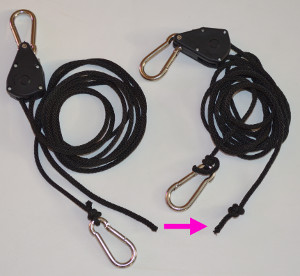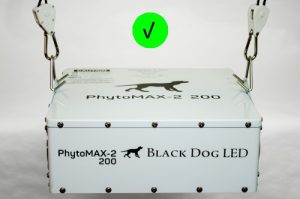PhytoMAX-2 General Information
Here you will find general information about all PhytoMAX-2 LED grow lights.
In the box you’ll find:
- 1 new PhytoMAX-2 LED growlight!
- 1 kettle plug with outlet CEE 7, Type F (Schuko) 2,5m
- 1 pair commercial LED hanger clips
- 1 pair Heavy Duty Ratcheting Light Hangers

Safety
- Be careful while hanging your PhytoMAX-2 LED plant growing lights; they’re heavy, do not attempt to hang the lights alone!
- NEVER look directly at the LEDs while they are on; eye damage may result. They’re very bright!
- Don’t over-load your electrical circuits!
- We recommend protective eyewear when viewing or working with plants under our lights. PhytoMAX-2 contains UV LEDs, which just like natural sunlight can irritate and damage your eyes. Any UV-blocking eyewear such as sunglasses will work!
Hanging your Light
- We recommend tying a stopper knot at the lose end of the rope to prevent over-extension of each of the ratcheting rope hangers.

- DO NOT attempt to hang a PhytoMAX-2 light alone- at least two people are recommended!
- Ensure that the structure you’ll be hanging the light from can support its weight plus some extra for cords, etc.
| Light | Weight |
|---|---|
| PhytoMAX-2 1000 | 24 kg |
| PhytoMAX-2 800 | 22.7 kg |
| PhytoMAX-2 600 | 15.4 kg |
| PhytoMAX-2 400 | 10.9 kg |
| PhytoMAX-2 200 | 6.4 kg |
- Insert a metal hanger clip into the hanging bracket either side of the back of the light. Ensure that both ends of each clip are secure.
- Clip one end of each of the ratcheting rope hangers to the hanging/anchor point on the ceiling, and the other end to the metal hanger clips attached to the light. The ropes should be hanging straight, not pulling the hanging brackets toward or away from the center of the light.


- Adjust the ratchet to hang the light at the recommended height.
- Ensure there is always a minimum of 15 cm / 6 inches of clearance on both sides of the light that have vents. Failure to provide adequate clearance can cause the light to overheat. The sides without vents and the top of the light do not require any clearance.

Recommendations for Proper Use
The footprint recommendations given here are created for photoperiod-sensitive plants in a square growing area. If your situation is any different (larger, smaller, different crop, etc.) you may need a different footprint size and hanging height.

The above footprint calculations were created for photoperiod-sensitive plants in a square area \ H.H. = Hanging Height
* Average PPFD measurements are over the entire footprint, edge-to-edge and corner-to-corner, based on reflective surroundings or adjacent lights.
** When growing in an area smaller than the Medium Recommended Flower Footprint, CO2 supplementation is generally required to make full use of the additional light.
- Vegetative vs. Flower
- The Phyto-Genesis Spectrum® in each PhytoMAX-2 light is ideal for both vegetative and flowering growth; only the largest recommended footprint size differs between stages, due to the different daily periods of illumination. You can use the flowering footprint sizes for vegetative growth, although you may need to increase fertilizer and CO2 to make full use of the extra light.
- Maximum Recommended Footprint Size
- This is as much as we recommend stretching our LED growing lights for photoperiod-sensitive plants, but running them over a smaller footprint (to a point) will give a higher yield per square foot. Other crops may have different ideal footprints.
- Hanging Height (H.H.)
- This is the recommended height of the bottom of your PhytoMAX-2 light, measured above the average top of the plant canopy. The higher you hang the light, the bigger (and weaker) its footprint will be; hanging it closer makes the light more intense but also decreases the footprint.
PhytoMAX-2 Growing Tips
There are two important differences when growing with PhytoMAX-2 LEDs:
- We recommend keeping your growing area 5 °C warmer than you would with other lights (29 °C) to maximize yield.
- This is because our lights are designed for plants, not humans.
- For more information, see our complete study on leaf surface temperature and grow lights.
- If not growing hydroponically, we recommend using fabric pots with our lights; they allow soil to dry out more quickly since our lights aren’t heating it as much. This allows faster nutrient cycling and encourages a better root system.
Cleaning and Maintenance
If your light requires cleaning:
- Turn off the light and disconnect the power cord.
- Spray water or a mild glass cleaner onto a soft lint-free towel (NOT onto the LEDs on the bottom of the light!)
- Gently blot the LEDs with the moist towel until clean. DO NOT RUB THE LEDs!
- Allow to air-dry, then plug your light back in and turn it on.
- NEVER spray any liquids directly on or around the LEDs!
Issues and Questions
Black Dog LED wants you to be satisfied with your PhytoMAX-2 light!
Please note that our LED growing lights contain infrared and ultraviolet diodes that are outside of humans’ visual range, so it is normal for some of the LEDs to appear dim or unlit.
Operating @ 230V:
-The PhytoMAX-2 grow lights have an average of 2,5 % lower power dissipation as with the 120V common in North Amerika. This is due to the ballasts operating more efficiently at 230V.
-Should the LEDs of your PhytoMAX-2 glow even after your timer has switched off the light, just unplug your timer, turn it 180° and re-plug it again. This glowing can occur due to induction voltage if the timer switches the neutral conductor instead of the live conductor.
If you have any questions or issues with your lights’ function, please contact Black Dog LED, not the store it was purchased from. You can:
Specifications
Common to All PhytoMAX-2 Lights:
| Acceptable voltage range | 100 – 250 volts AC |
|---|---|
| AC frequency range | 50 – 60 Hz |
| Operational temperature range | -20 to 40 °C |
| Spectrum | Phyto-Genesis Spectrum® covering 365-750nm, including UV and IR |
| Warranty | 5 Years |
| Certifications | ETL, CE, FCC, RoHS |
| M.T.B.F | > 50,000 hours |
| Power Factor | > 0.98 |
| Fans | 70,000 hour expected life |
The Phyto-Genesis Spectrum®:
Model Specifics:
| Light | Wattage (average) | Total Fixture Photon Flux (μMol/s) | # LEDs | BTUs | Size (LxWxH) (cm) |
Weight (kg) |
Amps (average) | ||||
|---|---|---|---|---|---|---|---|---|---|---|---|
| 300-800nm | UV (<400nm) | PAR (400-700nm) | IR (>700nm) | 120V | 240V | ||||||
| PhytoMAX-2 1000 | 1025 | 1602 | 73 | 1485 | 47 | 420 | 3581 | 53 x 53 x 17 | 24 | 8.8 | 4.4 |
| PhytoMAX-2 800 | 820 | 1282 | 58 | 1188 | 38 | 336 | 2864 | 53 x 53 x 17 | 22.7 | 7 | 3.5 |
| PhytoMAX-2 600 | 615 | 961 | 44 | 891 | 28 | 252 | 2148 | 48 x 48 x 13 | 15.4 | 5.3 | 2.6 |
| PhytoMAX-2 400 | 410 | 641 | 29 | 594 | 19 | 168 | 1432 | 40 x 40 x 13 | 10.9 | 3.5 | 1.8 |
| PhytoMAX-2 200 | 205 | 320 | 15 | 297 | 9 | 84 | 716 | 31 x 31 x 13 | 6.4 | 1.8 | 0.9 |
Total flux numbers from integration sphere tests of the entire fixture. Note that total photon flux is the entire photon output of the light (PPF, in μMol/s), and not the measurement at a particular point under the light (PPFD, in μMol/m2/s). When measured at a particular point, the PPFD can be much higher or lower than the total photon flux.
Footprint Coverage for Average PPFD
This table shows what footprint each model of light will cover to achieve a specific average photosynthetic photon flux density (PPFD). The PPFD is averaged every square centimeter over the entire footprint size given, edge-to-edge and corner-to-corner. For example, the PhytoMAX-2 200 provides an average of 100 μMol/m2/s (PPFD) over a 2.76 square meter area.

The footprint PAR coverage in this table assumes reasonably-reflective surroundings around the footprint; for adjacent lights the PPFD numbers or footprint coverage will actually be higher.
Transitioning Plants From Other Lights
When switching plants grown under other lights to PhytoMAX-2‘s Phyto-Genesis Spectrum®, some shock and/or stalling can occur, as with moving plants between any other different lighting situations. Our LED grow lights are very intense and contain UV light (unlike many grow lights), either of which can shock plants not used to such lighting.
To adapt plants to our lights with as little shock as possible, hang the light at twice the recommended hanging height to start. Each day for about a week you can lower the light by 15-20 cm until it is at the recommended hanging height and your plants have adapted.
When starting seeds under our lights it is fine to use the normal footprint and hanging height; when seeds germinate they adjust to the lighting conditions they first experience. Raising the hanging height of the light higher than normal during germination can lead to leggy, weak seedlings.
